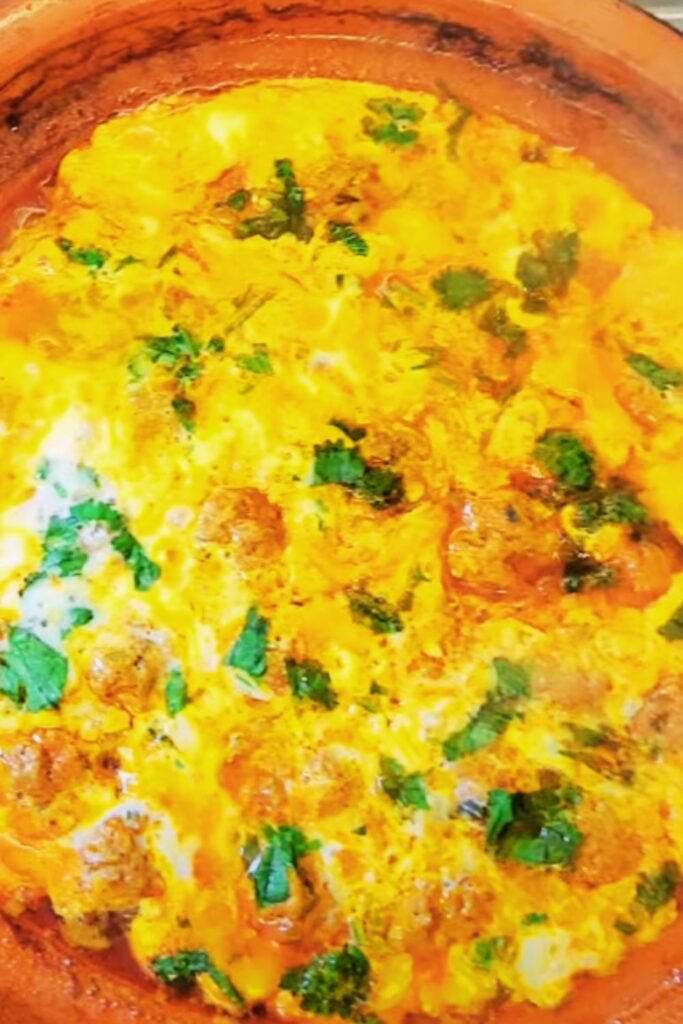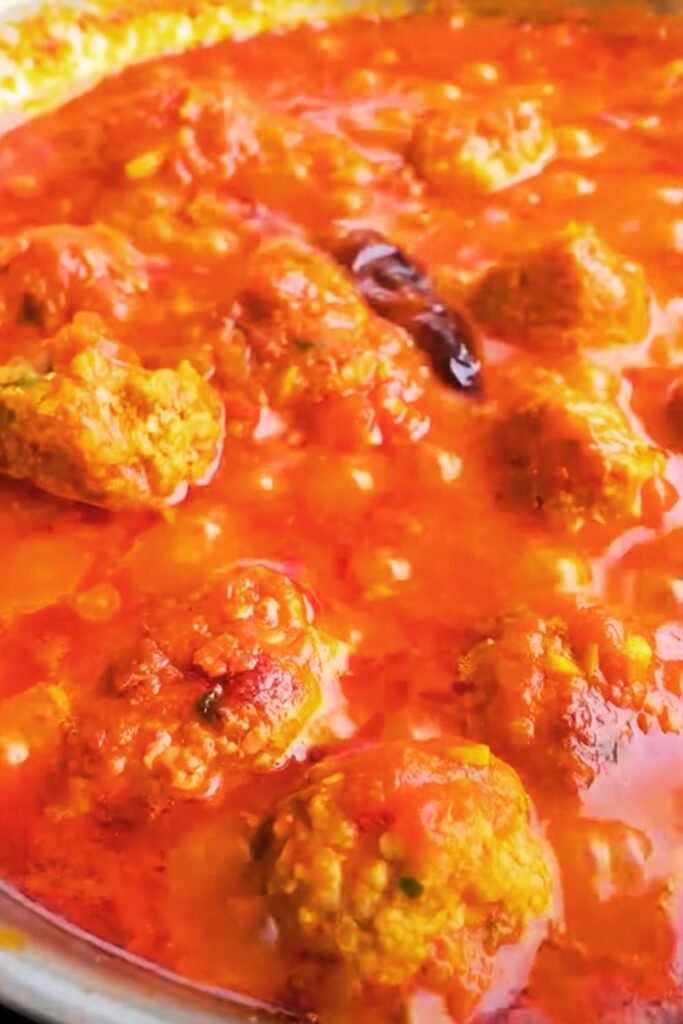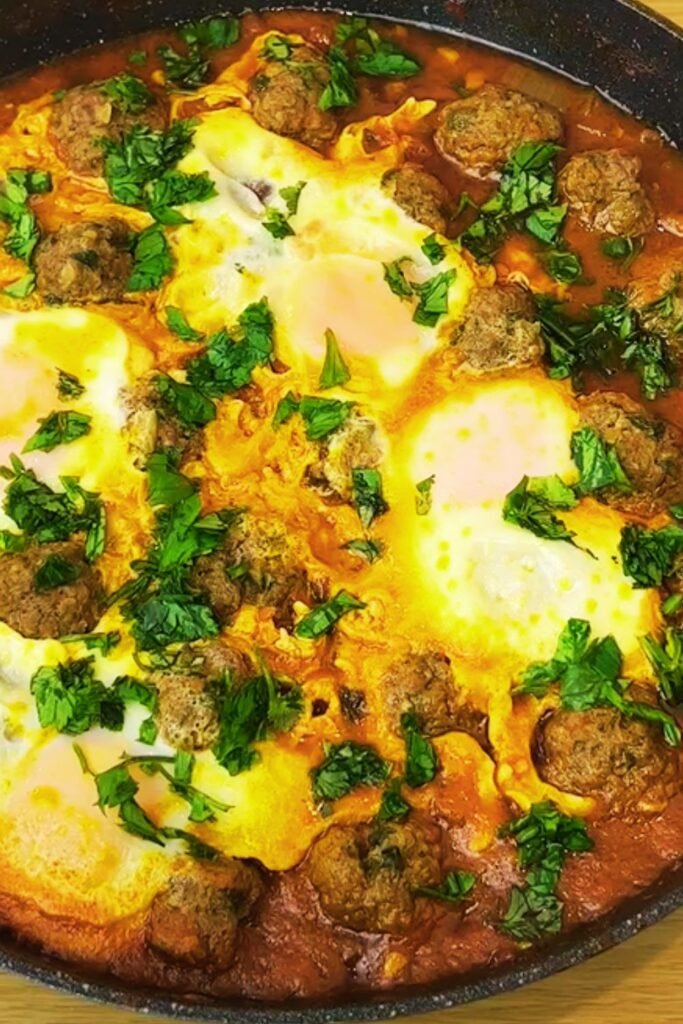When I first discovered the magic of Moroccan meatball tagine, I knew my cooking repertoire would never be the same. This isn’t just another meatball recipe – it’s a fragrant, soul-warming dish that transports you straight to the bustling souks of Marrakech with every single bite. The tender, spiced meatballs swimming in a rich, aromatic tomato sauce create a harmony of flavors that I’ve been perfecting for years.
My journey with this dish began during a culinary adventure in Morocco, where I learned that authentic meatball tagine, known locally as “kefta tagine,” represents the heart of Moroccan home cooking. The combination of warm spices, fresh herbs, and slow-cooked goodness creates something truly extraordinary that I’m excited to share with you today.
Understanding Moroccan Meatball Tagine
Tagine: A North African slow-cooking method using a cone-shaped earthenware pot, also referring to the dish cooked within it.
Kefta: Moroccan spiced ground meat mixture, typically beef or lamb, seasoned with traditional herbs and spices.
Ras el Hanout: A complex spice blend meaning “head of the shop,” containing up to 30 different spices.
Harissa: A hot chili paste common in North African cuisine, adding depth and heat to dishes.
The beauty of Moroccan meatball tagine lies in its perfect balance of sweet and savory elements. I’ve discovered that the secret isn’t just in the spices – though they’re crucial – but in the slow, patient cooking method that allows all flavors to meld together beautifully.
Essential Ingredients and Their Significance
Creating authentic Moroccan meatballs requires understanding each ingredient’s role in building the complex flavor profile that makes this dish so special.
For the Meatballs
| Ingredient | Quantity | Purpose | Substitution Options |
|---|---|---|---|
| Ground beef/lamb | 2 lbs | Main protein base | Ground turkey, chicken |
| Yellow onion | 1 large, grated | Moisture and sweetness | Shallots, white onion |
| Fresh parsley | 1/2 cup, chopped | Freshness and color | Cilantro |
| Fresh cilantro | 1/2 cup, chopped | Authentic Moroccan flavor | Additional parsley |
| Garlic cloves | 4 large, minced | Aromatic base | Garlic powder (1 tsp) |
| Ground cumin | 2 tsp | Earthy warmth | Whole cumin, ground |
| Ground coriander | 1 tsp | Citrusy notes | Ground fennel seed |
| Paprika | 2 tsp | Color and mild heat | Sweet paprika |
| Ground cinnamon | 1/2 tsp | Sweet warmth | Allspice |
| Ground ginger | 1 tsp | Spicy warmth | Fresh ginger, minced |
| Salt | 2 tsp | Flavor enhancement | Sea salt, kosher salt |
| Black pepper | 1 tsp | Heat and complexity | White pepper |
| Breadcrumbs | 1/2 cup | Binding agent | Soaked bread, rolled oats |
| Egg | 1 large | Binding protein | Flax egg, aquafaba |
For the Tagine Sauce
| Ingredient | Quantity | Purpose | Substitution Options |
|---|---|---|---|
| Olive oil | 3 tbsp | Cooking fat | Vegetable oil, avocado oil |
| Yellow onions | 2 medium, sliced | Sauce base | White onions |
| Garlic cloves | 6, minced | Aromatic foundation | Garlic paste |
| Fresh ginger | 2 tbsp, minced | Warm spice | Ground ginger (2 tsp) |
| Crushed tomatoes | 28 oz can | Sauce base | Fresh tomatoes, pureed |
| Tomato paste | 3 tbsp | Concentrated flavor | Double tomato sauce |
| Chicken broth | 2 cups | Liquid base | Vegetable broth, water |
| Ras el Hanout | 2 tbsp | Complex spice blend | Moroccan spice mix |
| Ground cumin | 2 tsp | Earthy depth | Whole cumin seeds |
| Ground coriander | 1 tsp | Fresh brightness | Coriander seeds |
| Paprika | 2 tsp | Color and flavor | Smoked paprika |
| Ground cinnamon | 1 tsp | Sweet warmth | Cinnamon stick |
| Cayenne pepper | 1/4 tsp | Heat level | Red pepper flakes |
| Honey | 2 tbsp | Balanced sweetness | Maple syrup, sugar |
| Preserved lemons | 2, chopped | Tangy brightness | Lemon zest + salt |
| Green olives | 1/2 cup | Briny complexity | Kalamata olives |
| Fresh herbs | For garnish | Final freshness | Dried herbs |

Step-by-Step Preparation Method
My approach to making perfect Moroccan meatballs has evolved through countless attempts, and I’ve refined this method to ensure consistent, delicious results every time.
Preparing the Meatballs
Step 1: Begin by combining all dry spices in a small bowl. I always toast my whole spices lightly in a dry pan before grinding them – this extra step intensifies their flavors dramatically.
Step 2: In a large mixing bowl, combine the ground meat with grated onion, minced garlic, chopped herbs, and all the spice mixture. I’ve learned that grating the onion rather than dicing it ensures better distribution and prevents chunks that might break apart during cooking.
Step 3: Add the beaten egg and breadcrumbs to the meat mixture. Using my hands, I gently combine everything until just mixed. Overmixing creates dense, tough meatballs – something I learned the hard way in my early attempts.
Step 4: Cover the mixture and refrigerate for at least 30 minutes. This resting period allows the flavors to meld and makes the mixture easier to shape.
Step 5: With damp hands, form the mixture into walnut-sized balls. I keep a bowl of water nearby to keep my hands moist, preventing the mixture from sticking.
Creating the Tagine Sauce
Step 6: Heat olive oil in a large, heavy-bottomed pot or tagine over medium heat. I prefer using my cast-iron Dutch oven when I’m not using my traditional tagine pot.
Step 7: Sauté the sliced onions until they become golden and caramelized, about 8-10 minutes. This step is crucial – properly caramelized onions add incredible depth to the final sauce.
Step 8: Add minced garlic and ginger, cooking until fragrant, approximately 1-2 minutes. The aroma at this point always reminds me why I fell in love with Moroccan cooking.
Step 9: Stir in tomato paste and cook for another 2 minutes, allowing it to darken slightly. This concentrates the tomato flavor and removes any raw taste.
Step 10: Add all the ground spices and cook for 30 seconds until fragrant. Be careful not to burn them – burnt spices create bitter flavors that can ruin the entire dish.
Step 11: Pour in the crushed tomatoes, chicken broth, and honey. Bring the mixture to a gentle simmer.

Combining and Final Cooking
Step 12: Carefully add the formed meatballs to the simmering sauce. I arrange them in a single layer when possible, ensuring they’re mostly submerged in the liquid.
Step 13: Cover and simmer on low heat for 35-40 minutes, turning the meatballs gently once halfway through cooking. The key here is patience – rushing this step results in tough meatballs and underdeveloped flavors.
Step 14: During the last 10 minutes of cooking, add the chopped preserved lemons and green olives. These ingredients provide the signature tangy, briny notes that make this dish authentically Moroccan.
Step 15: Taste and adjust seasoning as needed. I often add a pinch more honey if the sauce seems too acidic, or a squeeze of fresh lemon juice if it needs brightness.
Nutritional Information and Health Benefits
Understanding the nutritional profile of this dish helps me appreciate not just its delicious taste but also its contribution to a balanced diet.
Nutritional Breakdown (Per Serving, serves 6)
| Nutrient | Amount | % Daily Value | Health Benefit |
|---|---|---|---|
| Calories | 385 | 19% | Moderate calorie content |
| Protein | 28g | 56% | Muscle maintenance and growth |
| Total Fat | 22g | 28% | Essential fatty acids |
| Saturated Fat | 8g | 40% | Energy source |
| Carbohydrates | 18g | 6% | Quick energy |
| Dietary Fiber | 4g | 14% | Digestive health |
| Sugar | 12g | – | Natural fruit sugars |
| Sodium | 890mg | 39% | Electrolyte balance |
| Iron | 4.2mg | 23% | Oxygen transport |
| Vitamin C | 22mg | 24% | Immune system support |
| Calcium | 95mg | 7% | Bone health |
| Potassium | 785mg | 17% | Heart health |
Key Health Benefits
The spice blend in this dish provides numerous health benefits that I’ve come to appreciate over the years:
- Anti-inflammatory properties: Turmeric, ginger, and cinnamon contain compounds that help reduce inflammation
- Antioxidant rich: The combination of herbs and spices provides powerful antioxidants
- Digestive support: Cumin, coriander, and ginger aid in digestion
- Heart healthy: Olive oil and lean protein support cardiovascular health
- Immune boosting: Garlic, ginger, and vitamin C from tomatoes strengthen immunity
Serving Suggestions and Accompaniments
Over the years, I’ve experimented with various serving combinations, and these pairings have become my go-to recommendations for creating a complete Moroccan meal experience.
Traditional Accompaniments
| Accompaniment | Serving Size | Preparation Notes | Flavor Profile |
|---|---|---|---|
| Couscous | 1 cup per person | Steam with saffron and butter | Light, fluffy base |
| Flatbread (Khubz) | 2 pieces per person | Warm before serving | Soft, pillowy texture |
| Moroccan Rice | 3/4 cup per person | Cook with cinnamon stick | Aromatic, slightly sweet |
| Roasted Vegetables | 1 cup per person | Season with ras el hanout | Caramelized, spiced |
| Harissa Sauce | 1 tbsp per person | Serve on the side | Spicy, complex heat |
| Yogurt Sauce | 2 tbsp per person | Mix with mint and cucumber | Cool, refreshing contrast |
| Pickled Vegetables | 1/4 cup per person | Traditional turnips and carrots | Tangy, crunchy |
| Fresh Salad | Side portion | Tomatoes, cucumbers, herbs | Fresh, bright contrast |
Beverage Pairings
I’ve found that certain beverages complement this rich, spiced dish exceptionally well:
- Moroccan Mint Tea: The refreshing mint cuts through the richness perfectly
- Pomegranate Juice: Its tartness balances the warm spices beautifully
- Fresh Lemonade: Citrus brightness enhances the preserved lemon notes
- Sparkling Water with Lime: A palate cleanser between bites
- Hibiscus Tea: Its floral notes complement the complex spice blend

Storage and Reheating Guidelines
Proper storage has been crucial in my kitchen for meal prep and enjoying leftovers while maintaining the dish’s quality.
Storage Methods
| Storage Method | Duration | Container Type | Quality Retention |
|---|---|---|---|
| Refrigerator | 3-4 days | Airtight glass container | Excellent |
| Freezer | 2-3 months | Freezer-safe containers | Very good |
| Portion freezing | 3 months | Individual serving containers | Excellent |
Reheating Techniques
Stovetop Method: My preferred reheating method involves placing the meatballs and sauce in a covered pan over low heat, stirring gently and adding a splash of broth if needed.
Oven Method: Transfer to an oven-safe dish, cover with foil, and reheat at 325°F for 20-25 minutes until heated through.
Microwave Method: Use 50% power in 2-minute intervals, stirring between sessions to ensure even heating.
Recipe Variations and Adaptations
Through my cooking journey, I’ve developed several variations that cater to different dietary needs and preferences while maintaining the essence of this beloved dish.
Dietary Adaptations
| Variation | Key Changes | Cooking Notes | Flavor Impact |
|---|---|---|---|
| Gluten-Free | Use almond flour instead of breadcrumbs | May need extra binding | Slightly nuttier |
| Low-Carb | Serve with cauliflower rice | Reduce honey content | More vegetable-forward |
| Dairy-Free | Already naturally dairy-free | No substitutions needed | Original flavor maintained |
| Vegetarian | Use plant-based ground meat | Reduce cooking time slightly | Lighter texture |
| Spice-Sensitive | Reduce cayenne and paprika | Add extra herbs for flavor | Milder but still complex |
Troubleshooting Common Issues
From my years of making this dish, I’ve encountered and solved numerous challenges that home cooks often face.
Meatballs falling apart: Usually caused by insufficient binding agents or overworking the mixture. I always ensure adequate egg and breadcrumb ratios.
Sauce too thin: Simmer uncovered for the last 10 minutes, or mix a tablespoon of tomato paste with a little hot sauce and stir in.
Overly salty: Add a tablespoon of honey or a squeeze of lemon juice to balance the saltiness.
Lack of depth: This usually means the onions weren’t caramelized enough, or the spices weren’t properly bloomed in oil.
Meatballs too dense: Next time, handle the mixture more gently and ensure it’s not too cold when forming.
Q&A Section
Q. How long does it take to make Moroccan meatball tagine from start to finish?
The total time is approximately 2 hours, including 30 minutes of prep time, 30 minutes for chilling the meatball mixture, and about 1 hour of cooking time. I always recommend allowing extra time for the flavors to develop properly.
Q. Can I make the meatballs ahead of time and freeze them?
Absolutely! I often make double batches and freeze half. Form the meatballs, place them on a parchment-lined baking sheet, freeze until solid, then transfer to freezer bags. They can be cooked directly from frozen, just add an extra 10-15 minutes to the cooking time.
Q. What’s the best substitute if I can’t find preserved lemons?
I create a quick substitute by mixing the zest of 2 lemons with 1 tablespoon of coarse salt and letting it sit for 15 minutes. While not identical to traditional preserved lemons, it provides a similar bright, salty-citrus flavor.
Q. Can I use a regular pot instead of a tagine?
Definitely! I use my Dutch oven frequently with excellent results. The key is using a heavy-bottomed pot with a tight-fitting lid to ensure even heat distribution and proper moisture retention.
Q. How spicy is this dish, and can I adjust the heat level?
The dish has a mild to moderate heat level from the spices. I control the spiciness mainly through the cayenne pepper and can easily adjust it up or down based on preference. For those who love heat, I sometimes add a chopped jalapeño to the sauce.
Q. What’s the difference between using beef versus lamb?
Lamb provides a more traditional, slightly gamey flavor that’s authentic to Moroccan cuisine, while beef offers a milder taste that many find more approachable. I often use a combination of both for the best of both worlds.
Q. Can I make this dish in a slow cooker?
Yes, though the process differs slightly. I brown the meatballs first in a skillet, prepare the sauce base on the stovetop, then combine everything in the slow cooker for 4-6 hours on low heat.
Q. How do I know when the meatballs are properly cooked?
The meatballs should reach an internal temperature of 165°F (74°C) and feel firm to the touch. They’ll also have absorbed much of the sauce’s flavors and developed a rich, dark exterior.
Q. What should I do if my ras el hanout spice blend tastes bitter?
Bitterness usually indicates the spices were burned or are old. I always cook spices just until fragrant, never letting them darken significantly. Fresh, high-quality spice blends make a tremendous difference.
Q. Is this dish suitable for meal prep?
Absolutely! It’s one of my favorite meal prep dishes because the flavors actually improve over time. I portion it into individual containers with rice or couscous for easy weekday meals.
This Moroccan meatball tagine represents everything I love about North African cuisine – the warmth of the spices, the comfort of slow-cooked food, and the way it brings people together around the table. Every time I make this dish, I’m reminded of the power of traditional cooking methods and authentic flavors. The combination of tender, spiced meatballs in that rich, aromatic sauce creates a meal that’s both satisfying and transportive.
Whether you’re new to Moroccan cuisine or a seasoned enthusiast, this recipe offers a perfect gateway into the complex, beautiful flavors of North African cooking. I encourage you to take your time with each step, allowing the spices to work their magic and creating a dish that will undoubtedly become a cherished part of your culinary repertoire.